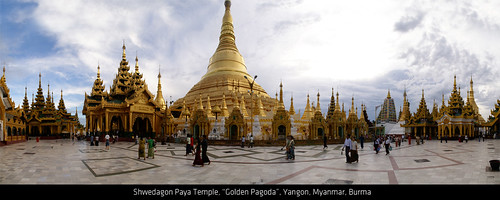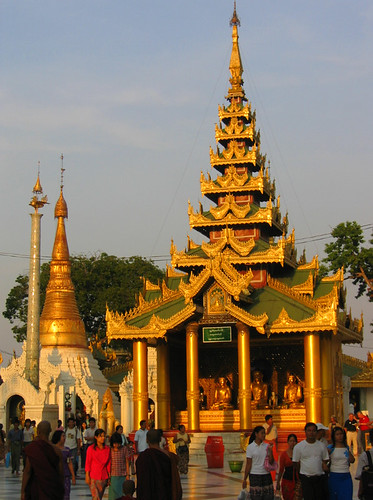
Shwedagon is a religious place chaired by the beautiful large Estupa Shwadagon Paya (in Burma known as the stupas Payas) that are located in Yangon, the former capital of Burma. Inside you can find relics of the Buddha Siddharta Gautama and hair, making it the beach sacred in the country.
Dating from its construccion and s.VI sX, but as a local legend is 2.500 years, and was built before the death of Buddha. Legend also has it that two brothers were merchants who were with Buddha and the eight of them gave their hair to create a sacred place for him with their hair on the inside as a Relic. The two merchants conducted their need and when they reached the hill Singuttara found other relics from the beach and built Shwadagon.
At one point, and Buddhist pilgrims left the beach and in the year 1300 the king ordered that a return Binnya rebuilt but this time I had 18 meters in height. It was rebuilt several times since then to get your current height. Later returned to be destroyed because of some earthquakes in the year 1768, and the king returned to rebuild Hsinbyushin the same way, and in 1871 the king ordered a new crown Mindon HTI (crown).
With the arrival of Portuguese and British site because of wars, looting and Paya suffered several destructions. In 1600 a Portuguese adventurer took the bell of 30 tons with the intention to merge to make guns, but the bell fell into the Bago River and could not be retrieved.
In the first war against the British, Paya The troops became a fortress dug beneath and to build an arsenal of weapons. This time, also tried to remove the bell in bronze, but came back to sink into the River. But this time, the Burmese succeeded in making it float recover placing below hundreds of bamboo.
Architecture of the Paya
The Estupa has a base built with bricks covered with gold above which there are several terraces pyissayan calls. The crown which culminates the upper deck is no less than 5,500 diamonds and 2,300 rubies.
The gold which has been on the beach was donated by the people of Burma and the monarchs, with the intention to preserve and maintain this amazing and impressive.
To go to the beach can do for four mouks (inputs), where there are stairs that lead up to the yin byin (a platform on the hill), where we see the image of the Buddha’s altar, presided over by two large lions called mystics Chinthe. Visitors walking around barefoot worshipers in the opposite direction to clockwise.

In the complex are more religious buildings, although the architecture is different from one another depending on the time of construction and that the offerings made at any time.
Leave a Reply
You must be logged in to post a comment.
Recent Comments